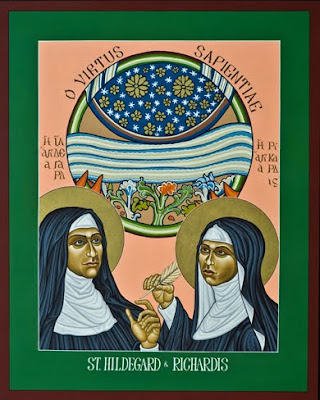The strength of vision. The life of Bingen's Ildegarda mystical
Article of Kitretredge Cherry published on his blog Jesus in Love (United States) on September 17, 2013, freely translated by Silvia Lanzi
Ildegarda di Bingen was a medieval German nun, mystical, poet, artist, composer, healer and scientist. He founded several monasteries, fought for women in the Church and wrote with passion of the Virgin Mary. Some say it was a lesbian because of his strong emotional attachment to women, especially his personal secretary Richardis von Stade. Ildegarda was declared a doctor of the church by Pope Benedict XVI in 2013. His party is September 17th.
 The title "Doctor of the Church" is a rare honor, granted only to a few saints whose writings have a universal value for the Church. Their "eminent teaching" and "great holiness" must be decreed by the Pope. At this moment the Catholic Church has only thirty -three doctors, including three women.
The title "Doctor of the Church" is a rare honor, granted only to a few saints whose writings have a universal value for the Church. Their "eminent teaching" and "great holiness" must be decreed by the Pope. At this moment the Catholic Church has only thirty -three doctors, including three women.
Friendship - or love story - between Ildegarda and Richardis is included in a 2009 film by the German feminist director Margarethe von Trotta entitledAus dem leben der Hildegard von Bingen (Life of Ildegarda di Bingen). Margarethe von Trotta is one of the most important feminist directors in the world and a leader of independent German cinema. Von Trotta allows Ildegarda to speak for herself, using a script based on the writings of Ildegarda itself and a soundtrack full of the music she composed.
Ildegarda also inspired a theatrical work by the feminist lesbian writer Carolyn Gage. In the work Artemisia and Ildegarda The writer makes two great artists of history debates on their conflicting theories of survival: Artemisia Gentileschi struggle to achieve a prominent position in the world of art dominated by men, while Ildegarda creates a community of women only to support her art by founding a monastery.
Ildegarda di Bingen (1098-1179), a tenth daughter of a noble family, was offered to the Church as "obsa", when she was still very young. It was raised since the age of eight in the hermitage that later became his Benedictine abbey. He founded two other convents, where women performed his music and developed their artistic, intellectual and spiritual gifts. He passed most of his life in the company of women. He had visions throughout his life, which began at the age of three, when he said he had seen "The shadow of living light". He hesitated to tell others his visions, sharing them only with his teacher Jutta.
A quarantadue anni Ildegarda ebbe una visione in cui Dio la istruiva a registrare le sue esperienze spirituali. Ancora esitante, si ammalò fisicamente prima di essere persuasa al suo primo lavoro di registrazione delle visioni, lo Scivias (Conosci le vie di Dio). Ildegarda venne curata durante la sua malattia e incoraggiata nella sua opera di scrittura da Richardis von Stade, una donna più giovane che era la sua segretaria personale, intima e favorita speciale. Fossero o meno in intimità fisica, le azioni di Ildegarda suggeriscono che fosse lesbica, nel senso che il suo interesse primario era verso le donne.
Nel 1151 Ildegarda completò lo Scivias e iniziarono dei problemi tra lei e la sua amata Richardis. Un arcivescovo, il fratello di Richardis, decise che sua sorella sarebbe diventata badessa di un convento distante. Ildegarda costrinse Richardis a rimanere e chiese anche al Papa di fermare il trasferimento. Ma Richardis se ne andò comunque, nonostante le obiezioni di Ildegarda. Scrisse lettere intense pregando Richardis di ritornare: “Amo la nobiltà della tua condotta, la tua saggezza e la tua castità, la tua anima e la tua vita tutta intera, molto di più di quelli che dicono: cosa stai facendo?”.
Richardis suddenly died in October 1151, when he was only around twenty -eight years. On his bed of death expressed his nostalgia for Ildegarda and his intention to return. The mourning of Ildegarda apparently raised his artistic creation even more. Some believe that Richardis had been the inspiration for theORDO VIRTUTUM ("The Order of Virtues"), a moralistic musical representation on a soul attempted by the devil who then regrets. According to Wikipedia "This is the oldest moralistic musical representation over a century and the only surviving medieval drama that rejects an attribution for both the text and for music".
In an era where few women wrote, Ildegarda created two of the greatest visionary works, a collection of songs and many scientific treaties. He was especially interested in women's health. His medical writings also include what could be the first description of a female orgasm. As the leader of the Ildegarda Church he had to give strongly to his policy against homosexual behavior. But often he wrote on the divine feminine and the dignity of women, presenting sexuality in a generally positive way. He wrote: "The creation looks to its creator as the beloved looks at the lover". Many readers today delibe with his erotic descriptions of marriage as a metaphor of the union of the soul to God. He writes:
“The soul is kissed by God in its most hidden regions.
They are granted, with inner brady, grace and blessing.
It is a burning desire to take the kind yoke of God on himself.
It is a burning desire to give itself to the streets of God. "
In Symphonia, a collection of liturgical songs for Mary, Ildegarda writes with ecstatic passion his love and devotion to the Virgin Mary. It exalts her like the "Grealer virgulto" and sings the praises of his womb that "He illuminated every creature". His music is also wonderful nowadays.
 Ildegarda died on September 17, 1179 at the age of eighty -one. The sisters of his convent said they had seen two rivers that formed a cross of colored lights over his room. It became a saint by popular acclamation.
Ildegarda died on September 17, 1179 at the age of eighty -one. The sisters of his convent said they had seen two rivers that formed a cross of colored lights over his room. It became a saint by popular acclamation.
The icon of Ildegarda and Richardis at the beginning of this post was painted by the artist of the Colorado Lewis Williams of the secular Franciscan order (ASS). Williams studied with the iconograph master Robert Lentz and made social justice a theme of his icons. This post also shows images of the artists Tricia Danby and Plamen Petrov.
Ildegarda appears as a young woman in the new portrait of Tricia Danby, a German spiritual artist, priest of the Veterocathian Apostolic Church. His images reveal the sensual side of his ecstatic union with God.
The creator of colored stained glass windows Plamen Petrov, from Chicago, is known for his window which represents the holy companions Sergio and Bacchus in the church of Santa Marta in Morton Grove in Illinois.
 His window representing Ildegarda the exhibition illuminated by wonderful aquamarine colors. The saint is then outlined in blue, with intense blue eyes, by Tobias Haller, iconographer, author, composer and vicar of the episcopal church of Saint James in the Bronx.
His window representing Ildegarda the exhibition illuminated by wonderful aquamarine colors. The saint is then outlined in blue, with intense blue eyes, by Tobias Haller, iconographer, author, composer and vicar of the episcopal church of Saint James in the Bronx.
Haller delights in increasing the variety of available icons by creating representations of LGBTQ people and other figures of progressive saints, as well as traditional ones. He and her husband were united in marriage with a religious ceremony more than thirty years ago and with a civil ceremony after homosexual marriages have become legal in New York.
Robert Lentz, a Franciscan friar known for its innovative Pro-Lgbt icons, portrays Ildegarda with a wild rose because she used to wet a rose in the Rhine to row water on people as a sign of blessing while traveling between one monastery and another. Lentz lives at the Holy Name College in Silver Springs, Maryland.
The Pro-Lgbt theologian Matthew Fox wrote two books on Ildegard's life and work. The most recent isHildegard of Bingen: A Saint For Our Times: Unleashing Her Power in the 21st Century (Ildegarda di Bingen, a saint for our time. How to free its power in the 21st century), who presents her as an "ecological warrior" who meets luminaries of the caliber of Albert Einstein, Howard Thurman, Dorothee Soelle and Clarissa Pinkola Exes. Fox also wroteIllumination of Hildegard of Bingen (the lighting of Ildegarda di Bingen).
Ildegarda was the topic of a sermon of the Bishop of the Episcopalian Church Katherine Jefferts Schori when the House of Bishops [organ of the Church of England, Ndt] met in Taiwan on September 17, 2014: "Ildegarda scientifically and theologically speaks of divine creativity such as Viriditas, reflecting both vitality (the freshness of the green color in the original) and the truth ... the vision of Ildegarda motivates all the healers of creation that understand the green network of the connection that binds together the creation in the body of wisdom".
Original text: Hildegard of Bingen and Richardis: Medieval Mystic and the Woman She Loved






